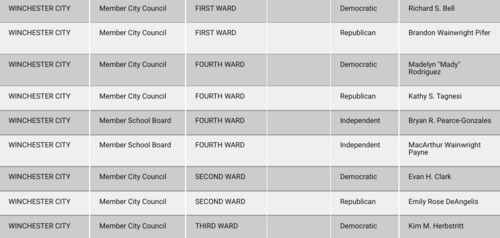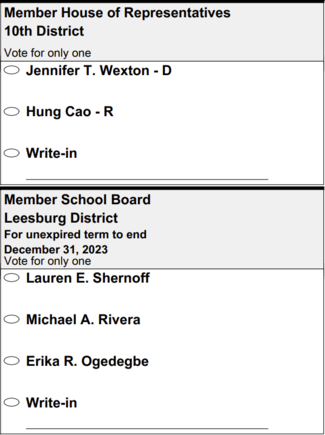Party labels in Virginia school board elections

|
| Virginia overview: • Election dates: Varies |
| Key policies: • Election dates and timing • Party labels on the ballot |
| Key terms • On-cycle elections • Off-cycle elections • Off-year elections • Off-date elections • Party labels • Partisan elections • Nonpartisan elections |
School board elections in Virginia are nonpartisan, which means party labels do not appear on the ballot for school board candidates.
![]() See law: Virginia Statutes Sections 22.1. Education and 24.1. Elections
See law: Virginia Statutes Sections 22.1. Education and 24.1. Elections
There were 132 public school districts in Virginia with a total of 809 school board member seats as of 2022. Those school districts operated a total of 2,015 schools serving 1,296,817 students.
Virginia is one of 41 states with state laws providing for nonpartisan school board elections.
The information in this page was last updated in 2022. Please email editor@ballotpedia.org with any updates, corrections, exceptions, or improvements.
School board elections in Virginia must be held at the same time as statewide general elections, which are held on the first Tuesday after the First Monday in November every year. School board elections are held every four years, every two years, or annually on varying schedules. State law allows school boards to be appointed or elected. District voters can change from an appointed school board to an elected school board or from an elected school board to an appointed school board through a petition and referendum process. As of 2023, the school board members of 119 out of the state's 132 districts were elected, and the members of the remaining 13 boards were appointed. The appointed school boards as of 2023 were Alleghany Highlands Public Schools, Franklin City Public Schools, Galax City Public Schools, Hanover County Public Schools, Hopewell City Public Schools, Lynchburg City Schools, Manassas Park City Schools, Martinsville City Public Schools, Poquoson City Public Schools, Richmond County Public Schools, Roanoke City Public Schools, Salem City Schools, and Williamsburg-James City County Public Schools.
![]() See law: Virginia Statutes Section 22.1-57.3 and the Virginia School Boards Association
See law: Virginia Statutes Section 22.1-57.3 and the Virginia School Boards Association
Virginia state law governing party labels on the ballot for school board elections
School board elections in Virginia are nonpartisan, which means party labels do not appear on the ballot for school board candidates. Virginia state law requires that school board candidates qualify for the ballot through the petition process for independent candidates. It does not allow school board candidates to qualify for the ballot as party nominees. This means that all school board candidates in Virginia are listed as independent in the secretary of state's official candidate list. On the ballot, the names of candidates are displayed without any party affiliation or additional disclosure of any kind. There is no route in state law for a school board candidate to be listed on the ballot with a party affiliation.
![]() See law: Virginia Statutes Sections 22.1. Education and 24.1. Elections
See law: Virginia Statutes Sections 22.1. Education and 24.1. Elections
Examples of how school board candidates appear on the ballot in Virginia
Below are excerpts from the state's candidate list and a sample ballot that show both school board candidates listed as either independent or without any identifier along with candidates for other types of offices that do have party affiliation displayed:
How does Virginia compare to other states?
Across the country, there are 13,187 public school districts governed by a total of 83,183 school board members. They are elected directly by voters except for a small handful of exceptions who are appointed.
As of July 2025, over 85% of school boards are elected without any party labels on the ballot identifying the candidates' affiliation with a political party. State laws in five states containing 1,169 school districts (9%) provide for party labels on the ballot for school board elections. In five states containing 554 districts (4%), state laws effectively provide for both the option of including or not including party labels on the ballot for school board elections. In the remaining states with elected local school board members, state law provides for school board elections without the inclusion of party labels on the ballot.
Elections in which party labels are included on the ballot are referred to as partisan elections. Elections in which party labels are not included on the ballot are referred to as nonpartisan elections.
The state laws of 40 states containing 11,472 school districts provide for school board elections without party labels identifying the affiliation of candidates listed on the ballot (nonpartisan elections).
State laws of five states provide for school board elections with party labels identifying the affiliation of candidates listed on the ballot (partisan elections):
State laws of five states containing 554 school districts effectively provide both options depending on the district. The details and the number of districts that fall in each category vary among the states. Those five states are:
See also
|
School board election rules: |
School board election coverage: |
Terms and context: |
| |||||
| ||||||||||||||||
Footnotes






